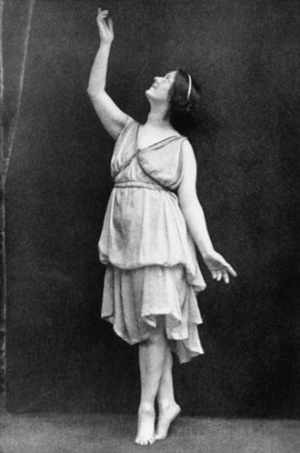

The basic "spiraling" position consists of rotating the spine approximately 45° around its vertical axis, so that a dancer facing the front of the stage would have their shoulders aligned with the "Via Triumphalis", an imaginary line parallel to a corner-to-corner diagonal of the stage. The second fundamental concept in Graham technique is the spiral. Graham's decision to make movement originate from the core rather than distally echoes the style of Isadora Duncan, but Duncan wrote in her autobiography that movement originates in the solar plexus rather than the low abdomen. The indexical meaning of the contraction in Graham's choreography is generally that the dancer is overcome with emotion, although the details depend on the specific context.

The contraction is associated with the exhale, and the release with the inhale, although this connection may be merely conceptual. The release may be considered a relatively passive return to a "normal" state, or alternatively an equally active outward propulsion of energy. The force of the contraction can be used to move the body through space or change its trajectory. The spine grows longer, not shorter, in a contraction. These muscles, along with the abdominal muscles, pull the spine into a concave arc from the coccyx to the nape of the neck, with the pelvis tucked and shoulders forward.

The contraction moves.Ī classic Graham contraction is a movement originating from the deep pelvic muscles. It is like a pebble thrown into the water, which makes rippling circles when it hits the water.

The phrase "Graham technique" was registered as a trademark before Graham's death, and was the subject of a trademark dispute in the early 2000s. Graham technique is known for its unique dramatic and expressive qualities and distinctive floorwork dance critic Anna Kisselgoff described it as "powerful, dynamic, jagged and filled with tension". Its other dominant principle is the "spiraling" of the torso around the axis of the spine. Graham technique is based on the opposition between contraction and release, a concept based on the breathing cycle which has become a "trademark" of modern dance forms. It is widely regarded as the first codified modern dance technique, and strongly influenced the later techniques of Merce Cunningham, Lester Horton, and Paul Taylor. Graham technique has been called the "cornerstone" of American modern dance, and has been taught worldwide. Graham technique is a modern dance movement style and pedagogy created by American dancer and choreographer Martha Graham (1894–1991). The central woman's pose shows the characteristic tension and theatricality of Graham technique. In learning Duncan repertory Belilove goes beyond the movements or “steps” to enrich the experience with the narrative behind the dance including references to other repertory pieces and choreographers.įrom Lori Belilove, “I chose to share this particular repertory piece, as the Water Study explores Duncan’s unique use of weight and musicality.The Martha Graham Dance Company in performance. Set to a short Schubert Waltz created ca.1914 for the Isadorables (Isadora’s company), this workshop includes a review of the Duncan waltz, focused warm-up to execute phrases from the dance, along with historical context, and inspiring videos and imagery sourced from nature and The Isadora Duncan Foundation Archives. This three hour workshop will include a warm-up, all phrases from the dance, historical context, and inspiring videos and imagery. 12 – 3PM EST – In-person and ZOOM options available


 0 kommentar(er)
0 kommentar(er)
